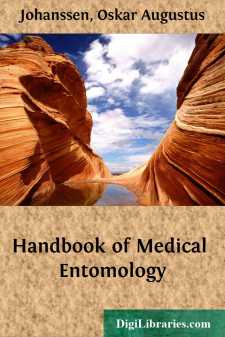Categories
- Antiques & Collectibles 13
- Architecture 36
- Art 48
- Bibles 22
- Biography & Autobiography 813
- Body, Mind & Spirit 142
- Business & Economics 28
- Children's Books 15
- Children's Fiction 12
- Computers 4
- Cooking 94
- Crafts & Hobbies 4
- Drama 346
- Education 46
- Family & Relationships 57
- Fiction 11828
- Games 19
- Gardening 17
- Health & Fitness 34
- History 1377
- House & Home 1
- Humor 147
- Juvenile Fiction 1873
- Juvenile Nonfiction 202
- Language Arts & Disciplines 88
- Law 16
- Literary Collections 686
- Literary Criticism 179
- Mathematics 13
- Medical 41
- Music 40
- Nature 179
- Non-Classifiable 1768
- Performing Arts 7
- Periodicals 1453
- Philosophy 64
- Photography 2
- Poetry 896
- Political Science 203
- Psychology 42
- Reference 154
- Religion 513
- Science 126
- Self-Help 84
- Social Science 81
- Sports & Recreation 34
- Study Aids 3
- Technology & Engineering 59
- Transportation 23
- Travel 463
- True Crime 29
Handbook of Medical Entomology
Description:
Excerpt
INTRODUCTION
EARLY SUGGESTIONS REGARDING THE TRANSMISSION OF DISEASE BY INSECTS
Until very recent years insects and their allies have been considered as of economic importance merely in so far as they are an annoyance or direct menace to man, or his flocks and herds, or are injurious to his crops. It is only within the past fifteen years that there has sprung into prominence the knowledge that in another and much more insiduous manner, they may be the enemy of mankind, that they may be among the most important of the disseminators of disease. In this brief period, such knowledge has completely revolutionized our methods of control of certain diseases, and has become an important weapon in the fight for the conservation of health.
It is nowhere truer than in the case under consideration that however abrupt may be their coming into prominence, great movements and great discoveries do not arise suddenly. Centuries ago there was suggested the possibility that insects were concerned with the spread of disease, and from time to time there have appeared keen suggestions and logical hypotheses along this line, that lead us to marvel that the establishment of the truths should have been so long delayed.
One of the earliest of these references is by the Italian physician, Mercurialis, who lived from 1530 to 1607, during a period when Europe was being ravaged by the dread "black death", or plague. Concerning its transmission he wrote: "There can be no doubt that flies feed on the internal secretions of the diseased and dying, then, flying away, they deposit their excretions on the food in neighboring dwellings, and persons who eat of it are thus infected."
It would be difficult to formulate more clearly this aspect of the facts as we know them to-day, though it must always be borne in mind that we are prone to interpret such statements in the light of present-day knowledge. Mercurialis had no conception of the animate nature of contagion, and his statement was little more than a lucky guess.
Much more worthy of consideration is the approval which was given to his view by the German Jesuit, Athanasius Kircher in 1658. One cannot read carefully his works without believing that long before Leeuwenhook's discovery, Kircher had seen the larger species of bacteria. Moreover, he attributed the production of disease to these organisms and formulated, vaguely, to be sure, a theory of the animate nature of contagion. It has taken two and a half centuries to accumulate the facts to prove his hypothesis.
The theory of Mercurialis was not wholly lost sight of, for in the medical literature of the eighteenth century there are scattered references to flies as carriers of disease. Such a view seems even to have been more or less popularly accepted, in some cases. Gudger (1910), has pointed out that, as far back as 1769, Edward Bancroft, in "An Essay on the Natural History of Guiana in South America," wrote concerning the contagious skin-disease known as "Yaws": "It is usually believed that this disorder is communicated by the flies who have been feasting on a diseased object, to those persons who have sores, or scratches, which are uncovered; and from many observations, I think this is not improbable, as none ever receive this disorder whose skins are whole."
Approaching more closely the present epoch, we find that in 1848, Dr....


